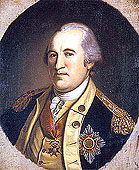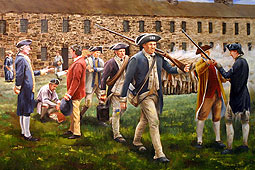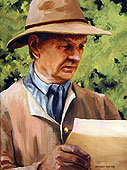For Teachers: Lessons
Lesson 2: War’s End: Promises of the Revolution
Learning Objectives
After completing this lesson, students will be able to:
- Analyze the economic and political challenges Americans faced at the end of the American Revolution
- Compare and contrast the concerns of the Confederation Congress with the concerns of army soldiers at the end of the war
- Compare and contrast the economic and political reality at the end of the war with soldiers' expectations
- Discuss the weakness of the Articles of Confederation that became apparent with the end of the war
- Explain the significance of the Newburgh Conspiracy
- Describe what life was like for the people in this scene
- Examine and analyze primary source materials
Skills
- Interpreting visual information
- Observing and describing
- Thinking critically
- Expressing opinions
- Analyzing visually
- Understanding historical perspective
- Gathering and using information
- Interpreting information
Introduction
In this lesson, students learn that amidst the relief, the pride and the hope for freedom and prosperity that accompanied American’s winning the war, the US had to confront a variety of serious problems and challenges, most immediately, the demobilization of the army. The scene is set at West Point, NY, where a group of men from a Massachusetts regiment is being demobilized.
 |
 |
 |
| Major General Friedrich Von Steuben, Pennsylvania Academy of Fine Arts, Philadephia, PA | War’s End, ©2008 Bryant White | Thomas Foster, © 2008 Bryant White |
Guiding Concepts
As the Revolutionary War ended, the army, the citizens, and the Confederation Congress faced a variety of economic and political challenges, most significantly, how to demobilize peaceably the thousands of soldiers who made up the Continental Army and whose pay was in arrears. The Congress adopted a variety of policies to deal with this situation—policies which had great impact on soldiers and citizens alike. In the aftermath of the war, soldiers’ economic and political reality compared unfavorably to their expectations.
Preparing to Teach
- Familiarize yourself with the Articles of Confederation, ratified in March of 1781, especially articles 8, 9 and 12. These can be found in the Artifacts & Documents section of the website. Search for manuscripts with a keyword of “Articles of Confederation.”
- Familiarize yourself with the War’s End historic scene, linked to from the Historic Scene menu. Read the three tabs, then roll your cursor over the highlighted hot spots in the illustration. Note that you can show all hotspots by clicking the Bullseye icon beneath the illustration on the left. Follow the links in the rollovers. Below the illustration and the tab content, read the four OBSERVER comments, the four essays in the THEMES section, and follow the links in the RELATED TO THIS SCENE section.
- Familiarize yourself with the Library of Congress’ Using Primary Resources.
- Although not explicitly referred to in the lesson, you can incorporate selections from the Timeline and Music section into the lesson.
Teaching the Lesson
- Class Assignment: Prior to the one or two class periods spent on this lesson, make the following assignment. Divide the class into two sections, one representing the Government/Confederation Congress, and one representing the Army. Assign each group the following website preparation:
- Both Groups: Go to the Artifacts & Documents section of the website. Search for the Articles of Confederation. Pay particular attention to Articles 8, 9 and 12. Go to the War’s End historic scene from the Historic Scene menu. Read the Overview tab, the rollovers in the illustration, the observer comments, and the four essays in the theme section. Note that rollovers for each tab differ from each other.
- Government/Confederation Congress Group: Read the Government tab; roll your cursor over the rollovers within the illustration and read the text. Pay particular attention to the observer comments of George Washington, Robert Morris, Friedrich von Steuben, and James Madison (Note: Washington and Madison have character narratives; you may want to assign specific students to read narratives so they can speak as these characters during class discussion). The character narratives are found in the People menu.
- Army: Read the Army tab; roll your cursor over the rollovers within the illustration and read the text. Follow the links and read the character narratives for Moses Sash, John Chaloner, and Thomas Foster. (Note: The Thomas Foster Diary does not appear on this website, but can be found at RevWar75, the website of Robert McDonald who made the transcription of the original document at the Huntington Library in San Marino, California, and who holds the copyright. He has given us permission to quote from the diary.) You may want to assign specific students to read each of the character narratives so they can speak as these characters during class discussion).
- Follow links to read about items in the related to this scene section.
- Class Activity: Ask the Army to sit on one side of the room and the Government to sit on the other side. Select one student to write notes on either a flipchart or blackboard at the front of the room. Label one side of the notes “Army” and one side “Government.” Draw a line vertically between the two.
- Ask for volunteers (or previously assigned students) to speak as George Washington, Robert Morris, Friedrich von Steuben, James Madison, Thomas Foster, Moses Sash, and John Chaloner, representing their points of view.
- Engage the class in an exercise of listing key concerns/problems/solutions facing the Government and the Army during demobilization. Possible listed items include: Government: no money to pay soldiers, concern about mutiny, furloughs as a possible solution, issuing of certificates, what to do with guns and uniforms, need for peaceful demobilization. Army: want to go home; need money, clothing, food, supplies; only get one month’s cash; need to sell certificates to get more money; sad to leave friends.
- Class Discussion Questions:
- How were the Articles of Confederation problematic for the Confederation Congress when it came to paying soldiers for their service in the Revolutionary War? (Congress was at the mercy of the individual states to raise money to pay debts.)
- What was the significance of the Newburgh Conspiracy? (The plot to launch a coup and set up martial law to secure for officers and men of the Continental Army back pay strengthened the hand of the Federalists.)
- What did Foster mean when he said “to only furlough us and not to pay us is an unheard of piece of injustice and not to be put up with by brave men that have fought and suffered everything but the dissolution of soul and body”? Why did the government favor the furlough system?
- Describe the condition of soldiers at the end of the war. Why were soldiers unhappy about getting paid in certificates? (tattered, tired, weary, no money, etc.)
- Why did a lot of soldiers sell their certificates? What happened to their value? (needed quick money; dropped in value)
- Who bought them, and who would eventually be able to cash them in? (speculators)
- What do you think of George Washington’s comment that “the Officers and Soldiers may expect considerable assistance in recommencing their civil occupations from the sums due to them from the public which must and will most inevitably be paid.”?
- Why did Von Steuben say that officers would accompany soldiers home to their states?
- How would you describe the thoughts and feelings of Moses Sash at the end of the war?
- What does the diary of Thomas Foster tell us about the condition of soldiers at the end of the war?
- In the aftermath of the war, how did the soldiers’ economic and political reality compare to their expectations? (stark difference)
Additional Resources
Books and Articles
- Kohn, Richard H., “The Inside History of the Newburgh Conspiracy: America and the Coup d'Etat”; The William and Mary Quarterly, Third Series, Vol. 27, No. 2 (Apr., 1970), pp. 188-220. Vol. 27, No. 2 (Apr., 1970), pp. 188-220.
- Gross, Robert, ed. In Debt to Shays: The Bicentennial of an Agrarian Rebellion, volume 65. Boston, MA: The Colonial Society of Massachusetts, 1993.
- Richards, Leonard. Shays’s Rebellion: The American Revolution’s Final Battle. Philadelphia: University of Pennsylvania Press, 2002.
- Starkey, Marion. A Little Rebellion. New York: Knopf, 1955.
- Satzmary, David. Shays’ Rebellion: The Making of an Agrarian Insurrection. Amherst, MA: University of Massachusetts Press, 1980.
Websites
- Gilder Lehrman Institute for American History: Seminar Document Project: The Era of George Washington: Washington and the Newburgh Conspiracy
- Library of Congress-Historian's Sources: Using Primary Resources
- Library of Congress: Digital Resources Related to the American Revolution
- Library of Congress: American Memory
- Shay’s Rebellion Song
- Best of History Websites: American Revolution and Independence
- PBS: Liberty: The American Revolution
- NEH Edsitement: History and Social Studies
- James Madison Center: US History Curricula
- History Institute, University of Massachusetts: Shays’ Rebellion and Related Resources
Movies
- The History Channel Series: 10 Days That Changed America: Shays’ Rebellion: America’s First Civil War; 60 minutes
- Calliope: A little Rebellion Now and Then: Prologue to the Constitution; 30 minutes